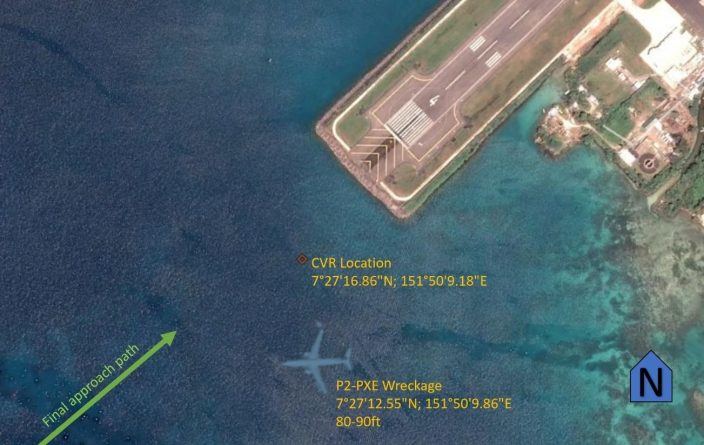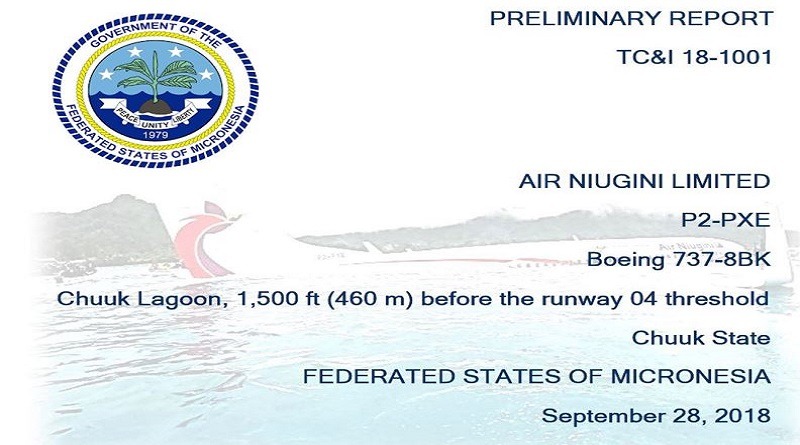History of the Flight
On Friday 28 September 2018, a Boeing 737-8BK aircraft, registered P2-PXE, was being operated by Air Niugini Limited, on a scheduled passenger flight from Pohnpei to Chuuk, Federated States of Micronesia.
At 23:45 UTC1 (09:45 local time) the aircraft impacted the water of Chuuk Lagoon about 1,500 ft (460 m) short of the runway 04 threshold, during its approach to runway 04 at Chuuk International Airport. As the aircraft settled in the water, it turned clockwise through 210 degrees and drifted 460 ft (140 m) south east of the runway 04 extended centreline, with the nose of the aircraft pointing about 265 deg.

There were 12 crew members and 35 passengers on board. Six passengers were seriously injured, and one passenger was fatally injured.
The 12 crew members and 34 passengers exited the aircraft and were promptly rescued and brought to shore by U.S. Navy divers (who were the first on scene), Chuuk State Government boats, Red Cross, Transco, and more than twenty privately-owned boats. Local divers located the fatally injured passenger in the aircraft 3 days after the accident.

The aircraft was substantially damaged by the impact forces the report said, stating no other damage to the plane while all communications between the air traffic services and the aircraft were normal.
The pilot in command was a 52 year old male Papua New Guinean with a total flying time of 19, 780.7 hours who had about 5.5 hours of sleep prior to the flight. His male co-pilot, a 35 year old Australian had a total flying time of 4, 618 hours; he had approximately 6.6 hours of sleep prior to the flight.
The investigation is reviewing the ground-based navigation aids, on-board navigation aids, and aerodrome visual ground aids and their serviceability at the time of the accident.
Flight Recorders
The aircraft was fitted with a solid-state cockpit voice recorder (SSCVR) and a separate solid-state flight data recorder (SSFDR). The SSFDR was located on its rack within the aircraft and was recovered by local divers.
The SSCVR was recovered from the seabed by US Navy divers about 440 feet (135 metres) back along the flight path from the 04 threshold, in the area ahead of the first point of water impact.
In accordance with PNG Accident Investigation Commission (PNG AIC) salt water recovery procedures, both recorders were washed and transported to the PNG AIC Flight Recorder Laboratory in Port Moresby for data recovery and readout. They were disassembled in the presence of an investigator from the FSM TC&I team, and the chip memory boards were thoroughly cleaned and dried before being connected to the Memory Access Retrieval System (MARS) download equipment.
An examination of the data showed that the SSFDR data and the SSCVR audio from the accident flight had been successfully recorded. The data was good quality.
Other electronic components of the aircraft recovered by the local divers included the Automatic Flight Information Recording System (AFIRS), Flight Management Computer (FMC) and the Enhanced Ground Proximity Warning System (EGPWS).
The EGPWS and the FMC were sent to the Manufacturer’s facilities in the US where specialised equipment will be used to recover the data under the supervision of Technical Advisers from the US National Transportation Safety Board.
Survival, Organisational and Management Information Aspects
All surviving occupants were rescued by local boaters and US Navy divers using small boats; one passenger who was initially unaccounted for was found deceased in the wreckage 3 days after the accident.
The areas of organisational and management information which may have directly or indirectly influenced the operation of the aircraft is the subject of the ongoing investigation. The organisational and management investigation may include, but not be limited to, the aircraft operator; the air traffic services; aerodrome and weather service agencies.
The investigation is continuing and will include, but will not be limited to, further examination and analysis of aircraft, crew, recorded data, aircraft operator, management and organisation data, weather and airport facilities.
The report’s recommendation included a statement from Air Niugini taking safety actions by re-categorising Chuuk Airport from a B to an X, which indicates it to be more restricted, and will initiate a category X training requirements for is flight crew.
‘Other similar airports in the Air Niugini Boeing network are being reviewed and may be re-categorised accordingly,’ stated Air Niugini.
See full report here: https://drive.google.com/open?id=10WA5kafTU9TBb_o-aG4eHxGFIk7YbKVJ
Source: Department of Transportation, Communications & Infrastructure’s (DTC&I) Division of Civil Aviation, of the Government of the Federated States of Micronesia (FSM)


